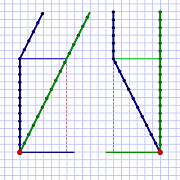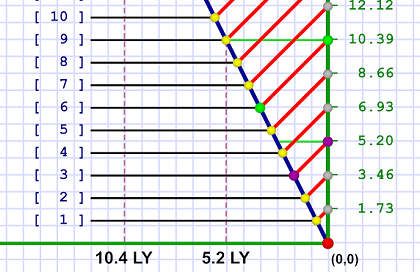SR #20: One-way Symmetry
 “Avengers Assemble!” No, wait…
“Avengers Assemble!” No, wait…Last time we watched friend Em make a six light-year trip to planet Noether while friend Al stays home on Earth working on Theories. It turns out that Al ages 27 years while Em ages only 23 (point 8). This is not due to special diet, but to Special Relativity slowing Em's clock on account of her fast motion through space.
We also saw that once Em stops at Noether, this breaks the symmetry of the two valid points of view regarding their motion (Em and ship are moving vs Al, Earth, and space, are moving).
Today we examine the trip before that point, while it is symmetrical.
So we have two points of view: ① Al stays on Earth while Em takes off in a spaceship for Noether; or ② Em sits in a motionless spaceship while Al, the Earth, Noether, and all of space zoom past. The goal is to show that both are entirely and equally valid.
Here is that part of the trip from both points of view:
 Diagram 1. Al's POV. Diagram 1. Al's POV. |
 Diagram 2. Em's POV. Diagram 2. Em's POV. |
On the left, diagram 1 shows Al's frame of reference; on the right, diagram 2 shows Em's. Shown along the sides of each diagram are the years that elapse on Al's and Em's respective clocks given the two points of view. So long as motion continues, the diagrams extend upwards.
The punchline is that Em stops. Formally speaking, she re-enters Al's frame of reference, which makes his view the one both now share. Since, in his view Em's clock ran slower, that becomes the view for both.
 Two ways of looking at the proposition "Al enters Em's frame of reference" (by getting on his own ship). Either way, they end up with their world lines running in parallel.
Two ways of looking at the proposition "Al enters Em's frame of reference" (by getting on his own ship). Either way, they end up with their world lines running in parallel.For Al to enter Em's frame, he would have to get on a spaceship that follows hers at the same speed. (And she would have to keep going to maintain her frame of reference.)
If Al did this, then Em's view that Al's clock runs slower would obtain for both of them and Al would be younger than Em (see diagram to right).
According to both diagram 1 and diagram 2, Al fires off his "How was your trip?" message in his year six and Em receives it in her year 10.4 (just as she reaches Noether).
It appears that, as far as this light signal between the two, the symmetry remains.
What if Em signals Al? Once she stops at Noether, she's back in Al's frame, so light signals are nothing special. They pass back and forth between Earth and Noether taking six years each way.
The real question is what if Em signals Al during the trip? What if Al signals Em during the trip? What does the light they receive from each other tell them about the situation?
Here are two diagrams illustrating what it looks like if Al and Em send regular laser messages to each other during the trip:
In diagram 3 above, Al sends a laser message to Em's spaceship every year. That message contains the date, so when Em gets the message, she knows when Al sent it. Diagram 4 below case reverses the situation. Em sends Al a time-stamped message every year. Note that both diagrams show Al's frame of reference in which Em is moving.
The numbers in brackets represent the time-stamped message. The plain numbers show when the message is received. (In Em's case I also showed Al's time in parentheses. For example, when Em's clock reads 1 year, from Al's perspective, he's at 1.15 years.)
Let's consider just one instance. Remember how Al sends Em a message at his year 6 (and she receives it in her year 10.4). That one is shown in diagram 3 with green dots.
The mirror version appears in diagram 4. Em sends a message at her year 6 and Al receives it in his year 10.4. You can check others, but you'll find that symmetry is preserved in terms of sending signals back and forth.
At least from Al's point of view. How about Em's? Here are the same sort of diagrams from Em's perspective:
As before, the diagram above shows Al sending yearly messages to Em; the diagram below shows Em sending yearly messages to Al. Unlike before, note that these both show Em's frame of reference (in which Al is moving).
As you can see, the situation between Al and Em remains symmetrical in both frames of reference. Any laser messages they send maintain the validity of both points of view. (Slower message methods, say a "message torpedo," encounter the same thing. Nothing Al or Em do breaks the symmetry unless one of them changes speed.)
So what about the return path? Here's what that looks like:
Above, Al sending messages to Em every year prior to expecting to see her return. Below, Em sending the same sort of messages to Al. Both diagrams are in Al's frame of reference.
While these project back from the expected meeting time, it wouldn't matter if their clocks had other initial settings — the math still keeps the symmetry of dual views.
For instance (see purple dots), if either sends a message 6 years prior to meeting, the other receives it 3.46 years prior to that meeting. (I won't do the diagrams for Em's frame of reference. You can assume they are mirrors of these or get out some graph paper and draw some lines!)
An important point here is that Al and Em know the distances involved. When Em is on Noether, she knows messages take 6 years to travel because Noether is 6 light-years away from Earth. Likewise, any calculations they make about the signals they receive assume they know the distance the signal traveled.
 Where is
Where is They can achieve this in a variety of ways. For one, they can send their location along with the time in their message.
For example, at year 6 Em might send: "T=6, X=3.2" (I'll leave it to you to figure out how she knows her x coordinate.)
The bottom line is that there are no signals Al and Em can send that break the symmetrical validity of the two views. In one frame of reference, Al moves, in another, Em moves (in yet another, the Turtle moves). All valid.
So long as the speed remains constant.
 And what does Em report about her x coordinate in this frame of reference?.
And what does Em report about her x coordinate in this frame of reference?.As a side note (for now): On the outbound trip, both Al and Em receive messages at longer intervals than they are sent at — almost twice as long (1.73, to be precise). This is due to the diverging path, the growing distance.
On the inbound trip, due to the converging path, the interval between received messages is shorter (0.58, the inverse of the stretching). The compression and stretching of received message interval is tied to speed.
When there is no motion, messages are received at the same intervals at which they're sent.
And on that note, I think we'll call it a day.
Next time we'll look at what happens to Em when she does stop at Noether, and what happens when she begins her trip back.





